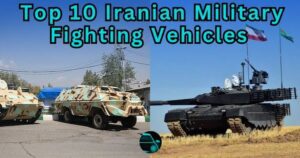Israel, known for its advanced military technology and innovative defense systems, has developed a wide range of fighting vehicles that are central to its military prowess. Due to the country’s unique geopolitical situation, Israel has been compelled to create some of the world’s most robust and versatile fighting vehicles. These vehicles are designed not only to engage in direct combat but also to navigate Israel’s diverse terrain, from urban centers to desert landscapes.
In this article, we will explore the top 10 Israeli military fighting vehicles, delving into their capabilities, technological innovations, and their critical role in Israel’s defense strategy. This comprehensive overview will give you insights into how these fighting vehicles help maintain Israel’s security and military superiority.
Top 10 Israeli Military Fighting Vehicles
1. Merkava Main Battle Tank

The Merkava is arguably the most iconic and formidable of all Israel’s fighting vehicles. It has served as the backbone of the Israeli Defense Forces (IDF) armored corps since its introduction in 1979. Designed with crew protection in mind, the Merkava features a front-mounted engine that provides additional shielding for its occupants. This unique design allows the tank to double as a heavy armored personnel carrier (APC), further enhancing its versatility on the battlefield.
The latest variant, the Merkava Mark IV, comes equipped with advanced fire control systems, modular armor, and the Trophy active protection system (APS), which can intercept incoming anti-tank missiles and RPGs. The Merkava’s combination of heavy firepower, strong protection, and multi-role capabilities makes it a standout among Israel’s fighting vehicles.
2. Namer Armored Personnel Carrier

The Namer APC is another example of Israel’s ingenuity in designing fighting vehicles with a focus on troop protection. The Namer, which means “leopard” in Hebrew, is based on the Merkava chassis and is one of the heaviest and most well-protected APCs in the world.
With the same advanced armor as the Merkava, the Namer can carry up to 12 soldiers, providing them with unparalleled protection on the battlefield. It is armed with a remote-controlled 12.7 mm machine gun and can also be fitted with mortars or other weapon systems as needed. The Namer is a critical asset in urban warfare, where the protection of infantry units is essential, and it is widely regarded as one of the most formidable fighting vehicles in the Israeli military.
3. Achzarit Armored Personnel Carrier

The Achzarit is another prominent Israeli fighting vehicle, designed for troop transport in high-threat environments. Developed in the late 1980s, the Achzarit is built on the chassis of captured Soviet T-55 tanks, which were heavily modified to create a heavily armored APC. The Achzarit’s name, meaning “cruel” in Hebrew, reflects its toughness on the battlefield.
Equipped with advanced armor and a remotely operated weapon station, the Achzarit can transport troops safely through dangerous terrain while offering firepower to suppress enemy forces. Its unique design allows for rapid entry and exit, which is crucial during fast-paced combat operations. The Achzarit remains a key player in Israel’s military strategy for urban and close-quarters combat.
4. Eitan Armored Personnel Carrier

Introduced in 2016, the Eitan APC is Israel’s first 8×8 wheeled armored personnel carrier. Unlike the Merkava-based Namer, the Eitan was designed to be more mobile and cost-effective, offering a lighter alternative to Israel’s tracked fighting vehicles.
The Eitan can carry 12 infantry soldiers and is equipped with advanced defensive systems, including the Trophy APS, similar to the Merkava and Namer. It also features a 30 mm automatic cannon and is capable of being outfitted with anti-tank missiles. This new vehicle enhances the IDF’s ability to quickly deploy troops in diverse environments while maintaining high levels of protection. The Eitan’s mobility, combined with its robust defensive capabilities, has made it a vital component of Israel’s fighting vehicles fleet.
5. Pereh Anti-Tank Missile Carrier

The Pereh is one of Israel’s more secretive and lesser-known fighting vehicles, designed for anti-tank warfare. For years, the existence of the Pereh was kept hidden from the public eye, with its appearance resembling a tank but concealing a deadly surprise. Beneath what appears to be a standard tank turret lies a launcher capable of firing anti-tank missiles.
The Pereh is based on the Magach tank chassis and carries Tamuz (Spike) guided missiles, which have a range of up to 25 kilometers. Its ability to engage enemy tanks from a distance while disguised as a conventional tank gives the Pereh a strategic advantage, making it one of Israel’s most unique fighting vehicles in the battle against armored threats.
6. Magach Main Battle Tank

The Magach series, based on the American M48 and M60 tanks, has been extensively modified and upgraded by Israel over the years to meet the IDF’s specific needs. The Magach tanks played a vital role in several of Israel’s wars, including the Yom Kippur War and the Lebanon War. Over time, Israel added reactive armor, improved fire control systems, and better crew protection, making these tanks more resilient in combat.
Although the Magach has been largely replaced by the Merkava in front-line service, it still serves in reserve and support roles. These upgrades have ensured that the Magach fighting vehicles remain relevant and combat-ready, contributing to Israel’s armored strength.
7. M109 Doher Self-Propelled Howitzer

Artillery plays a crucial role in any military, and Israel’s M109 Doher is one of the most powerful artillery fighting vehicles in its arsenal. The Doher is an Israeli-modified version of the American M109 self-propelled howitzer. It provides indirect fire support for the IDF, capable of firing 155 mm shells with a range of up to 30 kilometers.
The M109 Doher is equipped with modern navigation and fire control systems, allowing it to fire accurately and swiftly in battlefield conditions. This self-propelled howitzer is a key asset for Israel’s artillery units, capable of providing both offensive and defensive firepower during military operations.
8. Carmel Light Armored Vehicle

The Carmel is an experimental fighting vehicle that showcases Israel’s forward-thinking approach to military technology. The Carmel is part of Israel’s push toward autonomous and semi-autonomous fighting vehicles that can operate with minimal crew or even independently.
This light armored vehicle is being developed with advanced artificial intelligence (AI) systems, allowing it to process battlefield data, identify threats, and even engage targets with minimal human intervention. Although still in the development phase, the Carmel represents the future of Israel’s fighting vehicles, combining AI, robotics, and advanced weaponry to create a next-generation combat platform.
9. Merkava ARV (Armored Recovery Vehicle)

In addition to its powerful tanks and APCs, Israel also fields support vehicles like the Merkava ARV. Based on the Merkava chassis, the ARV is designed to recover damaged fighting vehicles and provide field repairs during combat.
This heavily armored recovery vehicle is equipped with a crane, winch, and other tools necessary for battlefield recovery operations. The Merkava ARV is vital to maintaining the IDF’s operational tempo, ensuring that damaged tanks and vehicles can be recovered and repaired quickly, keeping Israeli armored units in the fight.
10. SandCat Light Armored Vehicle

The SandCat, manufactured by Israeli company Plasan, is a light armored vehicle designed for a variety of roles, including border patrol, reconnaissance, and urban combat. Despite its relatively light weight, the SandCat offers significant protection against small arms fire and IEDs, thanks to its advanced composite armor.
The SandCat’s versatility and mobility make it a popular choice for both the IDF and international customers. Its modular design allows it to be configured for different missions, from troop transport to command and control. The SandCat is an excellent example of Israel’s ability to produce highly capable fighting vehicles that are adaptable to a wide range of operational environments.
Conclusion
Israel’s military industry has developed some of the world’s most advanced and battle-tested fighting vehicles, each designed to meet the unique challenges faced by the IDF. From the heavily armored Merkava tanks and Namer APCs to the agile Eitan and innovative Carmel, these vehicles are crucial to Israel’s defense strategy. They provide the IDF with the ability to engage in direct combat, transport troops safely through hostile environments, and support operations with artillery and recovery capabilities.
In a region where threats are diverse and constantly evolving, Israel’s fighting vehicles have proven their worth time and again. Their combination of firepower, protection, and mobility ensures that the IDF remains one of the most formidable military forces in the world. As technology advances, we can expect Israel to continue innovating, developing even more sophisticated fighting vehicles to meet the challenges of modern warfare.
These fighting vehicles not only play a crucial role in securing Israel’s borders but also serve as a testament to the country’s ability to produce world-class military equipment. With constant upgrades and cutting-edge designs, Israel’s fighting vehicles are a critical component of its military strength and technological innovation.
FAQ About Israeli Military Fighting Vehicles
1. What are the most advanced Israeli fighting vehicles in service today?
Israel has a reputation for developing some of the most sophisticated fighting vehicles in the world. The Merkava Main Battle Tank stands out as the most advanced, particularly in its latest version, the Merkava Mark IV. This tank is renowned for its unique design, which prioritizes crew protection by placing the engine at the front. It also features the Trophy active protection system, which intercepts incoming threats such as anti-tank missiles.
Other key Israeli fighting vehicles include the Namer Armored Personnel Carrier (APC), built on the Merkava tank chassis and considered one of the most heavily armored troop carriers globally. Israel also produces the Eitan, an 8×8 wheeled APC, which is lighter and more mobile than the Namer, as well as the Achzarit, a heavily armored APC based on converted Soviet T-55 tanks.
These fighting vehicles are designed to be versatile and robust, offering protection and firepower to soldiers in various combat scenarios. From urban warfare to open desert operations, Israel’s military relies heavily on these vehicles to maintain its defensive and offensive capabilities.
2. How does Israel’s Merkava tank compare to other main battle tanks around the world?
The Merkava is unique among main battle tanks due to its focus on crew survivability and adaptability. Most tanks prioritize firepower and mobility, but the Merkava’s front-mounted engine and spacious rear compartment, which can hold additional personnel or even wounded soldiers, set it apart. In terms of firepower, the Merkava is equipped with a 120mm smoothbore gun, capable of firing a range of munitions including anti-tank guided missiles.
Compared to other main battle tanks like the American M1 Abrams or the Russian T-90, the Merkava holds its own in terms of armor and protection systems. The Trophy active protection system, which is standard on Merkava tanks, gives Israel’s armored forces an edge against modern anti-tank weapons, effectively making the tank one of the hardest to destroy in combat. While the Merkava may not be as fast as some of its counterparts, its balance of firepower, protection, and multi-role capabilities makes it one of the most effective fighting vehicles in Israel’s military.
3. What makes Israel’s Namer APC stand out among armored personnel carriers?
The Namer is one of the heaviest and best-protected armored personnel carriers (APCs) in the world, designed to carry infantry safely into battle. Built on the same platform as the Merkava tank, the Namer benefits from the same advanced armor and Trophy active protection system that protects the Merkava from anti-tank missiles. This makes the Namer unique among APCs, as most APCs are not as heavily armored or equipped with such advanced defensive systems.
In addition to its protective features, the Namer can carry up to 12 soldiers and is equipped with a remote-controlled machine gun turret, ensuring that troops inside remain safe while engaging enemy forces. The Namer’s combination of heavy armor and firepower allows it to operate in high-threat environments, such as urban combat zones or during counter-insurgency operations. This makes the Namer a vital component of Israel’s mechanized infantry forces, capable of providing both troop transport and fire support.
4. What role do Israeli fighting vehicles play in regional conflicts?
Israel’s fighting vehicles are a crucial part of its military operations, particularly in regional conflicts. For example, Merkava tanks and Namer APCs have been deployed extensively in conflicts such as the 2006 Lebanon War and operations in Gaza. The heavily armored Achzarit APC, which is used in urban combat, and the SandCat light armored vehicle, designed for reconnaissance and patrols, are also commonly deployed in these operations.
In these conflict zones, Israeli fighting vehicles are often tasked with a variety of roles: from supporting infantry units in ground assaults to securing key defensive positions. The IDF has also relied on fighting vehicles like the Pereh anti-tank missile carrier to engage enemy tanks and fortifications from a distance, providing critical fire support to ground forces. Given the complex and hostile environments in which the Israeli military often operates, these vehicles are designed to be highly adaptable, offering protection, mobility, and firepower in equal measure.
5. How does Israel’s focus on indigenous fighting vehicle development benefit its military?
Israel’s emphasis on developing indigenous fighting vehicles provides several strategic advantages. First, it allows the Israeli military to tailor its equipment to the unique challenges of its geography and combat environment. For instance, the Merkava tank was designed with the rough, mountainous terrain of northern Israel and urban warfare scenarios in mind. Similarly, vehicles like the Namer and Eitan APCs are built to carry troops safely through hostile environments, such as dense urban areas or deserts.
Additionally, developing its own fighting vehicles ensures that Israel is not reliant on foreign suppliers, which can be especially important during times of conflict when access to international arms markets might be restricted. By producing its own vehicles, Israel can maintain a steady supply of military equipment, ensuring that its forces are always adequately equipped. Furthermore, Israel can continuously upgrade and modify its vehicles to incorporate the latest technological advances, as seen with the integration of the Trophy active protection system in the Merkava and Namer. This self-sufficiency in defense manufacturing has allowed Israel to maintain a highly capable and modern military force.




